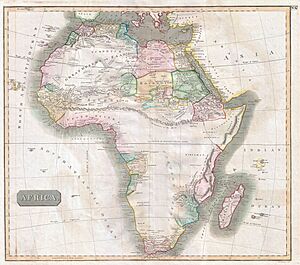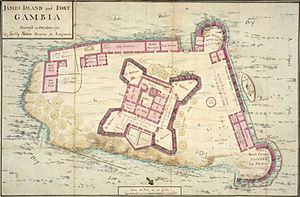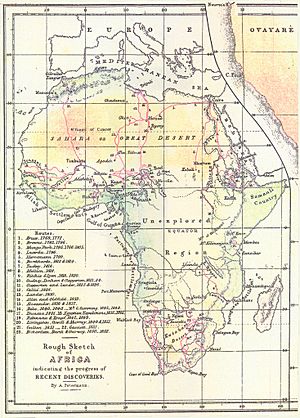European exploration of Africa facts for kids
For a long time, people in Europe knew a lot about the northern parts of Africa. This knowledge goes back to ancient Greek and Roman times. The area of Northwest Africa, called the Maghreb, was known as Libya or Africa. Egypt was often seen as part of Asia.
But exploring the parts of Africa south of the Sahara Desert (called Sub-Saharan Africa) began much later. This started in the 1400s during the Age of Discovery. Portugal, led by Prince Henry the Navigator, was a pioneer in this. In 1488, Bartolomeu Dias reached the Cape of Good Hope. This opened up an important sea route to India and the Far East. However, Europeans didn't explore much of Africa's inner lands in the 1500s and 1600s. They mostly set up trading posts along the coast. The inside of Africa was mainly explored by Arab slave traders. They created large trade networks and supported many kingdoms in the Sahel region.
By the early 1800s, Europeans still knew very little about inner Sub-Saharan Africa. Expeditions in the 1830s and 1840s explored South Africa. By the mid-1800s, the unknown areas were mostly the Congo Basin and the African Great Lakes. These areas were like "blank spots" on world maps. Famous 19th-century explorers like John Hanning Speke, Richard Francis Burton, David Livingstone, and Henry Morton Stanley helped map these last unknown parts by the 1870s. After this, the general shape of Africa was known. More expeditions, like those led by Oskar Lenz, added details about the continent's geology.
Contents
Ancient Explorers: Who Explored Africa First?
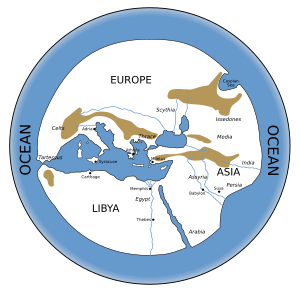
The Phoenicians were early explorers of North Africa. They set up many colonies, with Carthage being the most famous. Carthage itself explored West Africa. It's believed that Phoenician sailors were the first to sail all the way around Africa. This journey was ordered by Egyptian pharaoh Necho II around 600 BC and took three years.
The Greek historian Herodotus wrote about this trip. He said the sailors sailed south, went around the Cape, and then headed north to the Mediterranean Sea. They even stopped each year to plant and harvest crops. Herodotus found it hard to believe because the sailors said the Sun was on their right (north) when they were sailing south. This was confusing to him because he didn't know the Earth was round! Today, many think this detail actually proves the story is true.
The West African coast might have been explored by Hanno the Navigator around 500 BC. A report of his journey still exists. It's not clear how far Hanno went, but he definitely reached Sierra Leone. Some think he went as far as Guinea or even Gabon. Others believe he only went as far as southern Morocco.
The name Africa comes from the Afri people who lived in what is now Tunisia. The Roman province of Africa covered the Mediterranean coast of modern-day Libya, Tunisia, and Algeria. The parts of North Africa north of the Sahara were well-known in ancient times. However, before 200 BC, Greek mapmakers didn't know that the landmass called Libya stretched south of the Sahara. They thought the desert ended at the great Ocean.
By the Roman era, the Horn of Africa was well-known to Mediterranean geographers. A trading post called Rhapta might have been on the coast of modern Tanzania. A guide from the 1st century AD, the Periplus of the Erythraean Sea, shows knowledge of lands further south, in Southeast Africa. Ptolemy's world map from the 2nd century shows that Africa extends far south of the Horn of Africa. However, it doesn't have much detail south of the equator.
Arab Exploration and Trade in Africa
During the Middle Ages, much of the exploration of the Sahara and Sahel regions, as well as the Swahili coast (reaching Mozambique), was done by Muslim explorers and traders. At Mozambique, the Arab trade routes from the east met the Portuguese exploration routes from the west in the late 1400s.
After conquering North Africa in the 700s, Arab Muslims moved into Sub-Saharan Africa. They first went along the Nile Valley towards Nubia. Later, they also crossed the Sahara to West Africa. They were very interested in the trans-Saharan trade, especially in slaves.
This spread of Arab and Islamic culture happened slowly over many centuries. Christian kingdoms in Nubia faced pressure from the 600s but held on for centuries. The Kingdom of Makuria and Old Dongola fell by the early 1300s. Sufi orders played a big role in spreading Islam in Africa from the 800s to the 1300s. They followed trade routes between North Africa and the kingdoms of Ghana and Mali. The Mali Empire became Islamic after its ruler, Musa I, made a famous pilgrimage in 1324. Timbuktu became a major center of Islamic learning south of the Sahara.
Early European Expeditions: Portugal Leads the Way
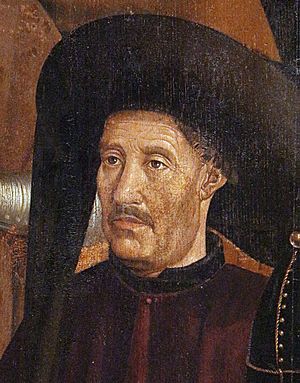
Prince Henry the Navigator of Portugal was the first European to systematically explore Africa and the sea route to India. From his home in southern Portugal, he sent out many expeditions to sail around Africa and reach India. In 1420, Henry sent a trip to claim the island of Madeira. In 1425, he tried to get the Canary Islands, but Spain already controlled them. In 1431, another Portuguese expedition reached and claimed the Azores.
Naval maps from 1339 show that Europeans already knew about the Canary Islands. In 1341, Portuguese and Italian explorers planned a joint trip. In 1342, Catalans organized an expedition to the Canary Islands. In 1344, Pope Clement VI named a French admiral, Luis de la Cerda, "Prince of Fortune" and sent him to conquer the Canaries. In 1402, Jean de Bethencourt and Gadifer de la Salle sailed to conquer the Canary Islands. They found them already raided by the Spanish. Even though they conquered the islands, Bethencourt's nephew had to give them to Spain in 1418.
In 1455 and 1456, two Italian explorers, Alvise Cadamosto and Antoniotto Usodimare, worked for Prince Henry. They explored the Gambia River and visited Senegal. Another Italian sailor, António de Noli, also working for Prince Henry, explored the Bijagós islands and the Cape Verde archipelago with the Portuguese Diogo Gomes. António de Noli became the first European governor in Sub-Saharan Africa.
Portuguese sailors made steady progress along Africa's coasts. They reached Cape Bojador in 1434 and Cape Blanco in 1441. In 1443, they built a fort on Arguin island in modern Mauritania. Here, they traded European goods for African gold and slaves. This was the first time "gold of the Sudan" reached Europe without Arab traders in the middle. Many slaves were sent to Madeira, which became the first European plantation colony. Between 1444 and 1447, the Portuguese explored the coasts of Senegal, Gambia, and Guinea. In 1456, Alvise Cadamosto explored the Cape Verde islands. In 1462, Portuguese sailors explored the Bissau islands and named Serra Leoa (Lioness Mountains).
In 1469, Fernão Gomes rented the rights to explore Africa for five years. Under his leadership, in 1471, the Portuguese reached modern Ghana. They settled in A Mina (the mine), now called Elmina. They had finally found a place with lots of gold, which is why this area was historically known as the "Gold Coast".
In 1472, Fernão do Pó discovered an island named after him (now Bioko). He also found an estuary full of shrimp, which gave its name to Cameroon. Soon after, Europeans crossed the equator. Portugal set up a base in São Tomé which was settled with criminals and later with expelled Spanish and Portuguese Jews.
In 1482, Diogo Cão found the mouth of a large river and learned about a great kingdom, Kongo. In 1485, he explored the river further upstream.
The Portuguese really wanted to find a sea route to India. They kept trying to sail around Africa. In 1488, Bartolomeu Dias and his pilot Pêro de Alenquer sailed around a stormy cape, which they called the Cape of Storms. They realized the coast continued eastward. Running low on supplies, they turned back, convinced they had reached the southern tip of Africa. When they returned to Portugal, the cape was renamed the Cape of Good Hope.
Years later, Christopher Columbus landed in America for Spain. Pope Alexander VI then divided the non-Christian world between Spain and Portugal.
Finally, from 1497 to 1498, Vasco da Gama, with Alenquer as his pilot again, took a direct route to the Cape of Good Hope. He sailed past where Dias had stopped and named the land Natal. He then sailed north, landing at Quelimane (Mozambique) and Mombasa (where he found Chinese traders). In Malindi (Kenya), he hired an Arab pilot who guided the Portuguese directly to Calicut in India. On August 28, 1498, King Manuel I of Portugal told the Pope the good news: Portugal had reached India!
Egypt and Venice were not happy about this. They attacked Portuguese ships trading with India from the Red Sea. But the Portuguese defeated them in 1509 near Diu. The Ottoman Empire didn't react much, so Portugal gained almost full control of trade in the Indian Ocean. They set up many bases along Africa's eastern coast, except for Somalia. The Portuguese also captured Aden in 1513.
One of the ships led by Diogo Dias reached a coast that wasn't in East Africa. Two years later, a map showed a long island east of Africa called Madagascar. But it took another century, from 1613 to 1619, for the Portuguese to explore the island in detail. They made agreements with local chiefs and sent the first missionaries. However, the missionaries were eventually expelled.
European Powers in Africa: Early Modern Era

The Portuguese presence in Africa soon clashed with existing Arab trade. By 1583, the Portuguese had settled in Zanzibar and along the Swahili coast. The Kingdom of Kongo became Christian in 1495, and its king took the name João I. The Portuguese also set up trade in the Kingdom of Mutapa in the 1500s. In 1629, they put a puppet ruler on the throne there.
The Portuguese (and later the Dutch) also got involved in the local slave trade. They supported the Jagga state, which carried out slave raids in the Congo. They used the Kongo to weaken the neighboring Ndongo kingdom. Queen Nzinga fought bravely against the Portuguese and Jagga, but eventually lost. Portugal's military actions in these conflicts led to the creation of their colony of Angola. In 1663, after another fight, the royal crown of Kongo was sent to Lisbon. However, a smaller Kongo Kingdom still existed until 1885.
The Portuguese dealt with the other major state in Southern Africa, the Monomotapa (in modern Zimbabwe), in a similar way. Portugal got involved in a local war hoping to find rich minerals. They imposed a protectorate, but this weakened the Monomotapa's authority, leading to chaos. Local miners moved away or even buried their mines to keep them from the Portuguese. In 1693, when the neighboring Cangamires invaded, the Portuguese gave up and went back to the coast.
Dutch Influence in Africa
Starting in the 1600s, the Netherlands began exploring and colonizing Africa. During their long war for independence against Spain, Portugal was temporarily united with Spain (1580-1640). Because of this, the Dutch focused their colonial efforts against Portugal.
Two Dutch companies were formed: the Dutch West India Company for the Atlantic Ocean and the Dutch East India Company for the Indian Ocean. The West India Company captured Elmina in 1637 and Luanda in 1640. However, the Portuguese drove them out of Luanda in 1648. Overall, the Dutch built 16 forts, including Gorée in Senegal. They partly took over from Portugal as the main slave-trading power. The Dutch Gold Coast and Dutch Slave Coast were successful.
In Dutch Mauritius, colonization began in 1638 and ended in 1710. There were many problems like cyclones, droughts, pests, lack of food, and sickness. The island was finally abandoned in 1710.
The Dutch had a lasting impact in South Africa. This region was ignored by Portugal. The Dutch decided to use it as a stop on their way to East Asia. Jan van Riebeeck founded Cape Town in 1652. This marked the start of European exploration and colonization of South Africa.
Other European Powers in the Early Modern Era
Around the same time as the Dutch, other European powers tried to set up their own trading posts for the African slave trade.
As early as 1530, English traders began trading in West Africa. They sometimes clashed with Portuguese troops. In 1581, Francis Drake reached the Cape of Good Hope. In 1663, the English built Fort James in The Gambia. A year later, another English expedition tried to settle southern Madagascar, but most colonists died. The English forts on the West African coast were eventually taken by the Dutch.
In 1626, the French Compagnie de l'Occident was created. This company drove the Dutch out of Senegambia (Senegal), making it the first French territory in Africa. They also conquered the island of Arguin.
France also looked at Madagascar, which had been used as a stop on trips to India since 1527. In 1642, the French East India Company founded a settlement in southern Madagascar called Fort Dauphin. This settlement didn't make much money, and most settlers died. One survivor, Etienne de Flacourt, wrote a book about Madagascar, which was the main European source of information about the island for a long time. Other settlement attempts also failed. In 1667, François Martin led the first expedition into the heart of Madagascar, reaching Lake Alaotra. In 1665, France officially claimed Madagascar, calling it Île Dauphine. However, there wasn't much colonial activity in Madagascar until the 1800s.
In 1651, the Duchy of Courland and Semigallia (a small state linked to Poland-Lithuania) gained a colony in Africa on St. Andrew's Island on the Gambia River. They built Jacob Fort there. The Duchy also took other local lands like St. Mary Island (modern-day Banjul) and Fort Jillifree.
In 1650, Swedish merchants founded the Swedish Gold Coast in modern Ghana. In 1652, they started building Fort Carlsborg. In 1658, Fort Carlsborg was taken and became part of the Danish Gold Coast colony, then the Dutch Gold Coast. Later, the local people successfully rebelled. In December 1660, the King of the Efutu offered Sweden control again. But in 1663, the Danes seized it after a long fight.
The Dano-Norwegians colonized the Danish Gold Coast. From 1674 to 1755, the settlements were managed by the Danish West India-Guinea Company. From 1680 to 1682, the Portuguese occupied Fort Christiansborg. In 1750, it became a Danish crown colony. From 1782 to 1785, it was under British control. From 1814, it became part of Denmark.
In 1677, King Frederick William I of Prussia sent an expedition to West Africa. The commander, Captain Blonk, signed agreements with chiefs on the Gold Coast. The Prussians built a fort called Gross-Friedrichsburg and rebuilt the abandoned Portuguese fort of Arguin. But in 1720, the king decided to sell these bases to the Netherlands for 7,000 gold coins and 12 slaves.
In 1777, the Spanish Empire and Portuguese Empire signed the First Treaty of San Ildefonso. Portugal gave Spain the islands of Annobón and Fernando Poo in the Gulf of Guinea, as well as the coast between the Niger River and the Ogooué River in Equatorial Guinea.
The British showed their interest by forming The Association for Promoting the Discovery of the Interior Parts of Africa in 1788. This group was inspired by James Bruce, a Scotsman who had traveled to Ethiopia in 1769 and reached the source of the Blue Nile.
Overall, European exploration of Africa in the 1600s and 1700s was very limited. They focused mostly on the slave trade, which only needed coastal bases. The real exploration of Africa's interior began much later, in the 1800s.
The 19th Century: Unveiling Africa's Interior
Even though the Napoleonic Wars distracted Europe, these wars greatly influenced Africa's future, especially in Egypt and South Africa. France and then Great Britain occupied Egypt (1798–1803). This made the Ottoman Empire want to regain control. In 1811, Mehemet Ali created an almost independent state. From 1820, he extended Egyptian rule over eastern Sudan. In South Africa, the fight with Napoleon led the United Kingdom to take over the Dutch settlements at the Cape. In 1814, the Cape Colony was formally given to the British crown.
Meanwhile, other parts of Africa changed. France's occupation of Algiers in 1830 ended piracy by the Barbary states. Egyptian power continued to grow southward, adding to knowledge of the Nile. The city of Zanzibar quickly became important. Stories of a huge inland sea and the discovery of the snow-covered Mount Kilimanjaro in 1840–1848 made Europeans want to know more about Africa.
In the mid-1800s, Protestant missions were active on the Guinea coast, in South Africa, and in Zanzibar. Missionaries visited little-known regions and people. Many became explorers and pioneers of trade. David Livingstone, a Scottish missionary, worked north of the Orange River from 1840. In 1849, Livingstone crossed the Kalahari Desert and reached Lake Ngami. Between 1851 and 1856, he traveled across the continent from west to east. He discovered the large waterways of the upper Zambezi River. In November 1855, Livingstone was the first European to see the famous Victoria Falls, named after Queen Victoria. From 1858 to 1864, Livingstone explored the lower Zambezi, the Shire River, and Lake Nyasa. Lake Nyasa had first been reached by a slave of António da Silva Porto, a Portuguese trader, who crossed Africa from Benguella to the mouth of the Rovuma between 1853 and 1856.
A main goal for explorers was to find the source of the Nile River. Expeditions by Burton and Speke (1857–1858) and Speke and Grant (1863) found Lake Tanganyika and Lake Victoria. It was later proven that the Nile flowed from Lake Victoria.
Henry Morton Stanley, who famously found Livingstone in 1871 (saying "Dr. Livingstone, I presume?"), started another expedition from Zanzibar in 1874. In one of the most famous exploring trips in Africa, Stanley sailed around Lake Victoria and Lake Tanganyika. He then followed the Lualaba River all the way to the Atlantic Ocean, reaching it in August 1877. This proved that the Lualaba was actually the Congo River.
In 1895, the British South Africa Company hired an American scout named Frederick Russell Burnham. He was tasked with finding minerals and better ways to navigate rivers in central and southern Africa. Burnham led an expedition that first showed there were large copper deposits north of the Zambezi River in North-Eastern Rhodesia. Along the Kafue River, Burnham saw many similarities to copper deposits he had worked on in the United States. He also met local people wearing copper bracelets. Copper quickly became the main export of Central Africa and is still important to the economy today.
Explorers were also active in other parts of the continent. Southern Morocco, the Sahara, and the Sudan were crossed in many directions between 1860 and 1875 by Georg August Schweinfurth and Gustav Nachtigal. These travelers not only added a lot to geographical knowledge but also gathered valuable information about the people, languages, and nature of the countries they visited. Among Schweinfurth's discoveries was one that confirmed old Greek stories about a "pygmy race" beyond Egypt. But the first Western explorer to find the pygmies of Central Africa was Paul Du Chaillu. He found them in the Ogowe district on the west coast in 1865, five years before Schweinfurth. Du Chaillu had also made the existence of the gorilla popular in Europe through his journeys in the Gabon region between 1855 and 1859. Before him, the gorilla was thought to be as legendary as the Pygmies.
Famous Explorers of Africa
Here are some of the key explorers who helped map and understand the African continent:
15th Century Pioneers
 Diogo Cão
Diogo Cão Bartolomeu Dias
Bartolomeu Dias Gil Eanes
Gil Eanes Nuno Tristão
Nuno Tristão Alvise Cadamosto (from Venice, Italy)
Alvise Cadamosto (from Venice, Italy) António de Noli (from Genoa, Italy)
António de Noli (from Genoa, Italy) Diogo Gomes
Diogo Gomes Fernão do Pó
Fernão do Pó
Late 15th / Early 16th Century
 Vasco da Gama (discovered the sea route to India)
Vasco da Gama (discovered the sea route to India) Diogo Dias (discovered Madagascar)
Diogo Dias (discovered Madagascar) Pêro da Covilhã (diplomat and explorer in Ethiopia)
Pêro da Covilhã (diplomat and explorer in Ethiopia) Pedro Álvares Cabral (explored India along the African coast)
Pedro Álvares Cabral (explored India along the African coast)
16th Century
 Paulo Dias de Novais
Paulo Dias de Novais António Fernandes (traveled to Monomotapa, exploring much of modern Zimbabwe)
António Fernandes (traveled to Monomotapa, exploring much of modern Zimbabwe) Lourenço Marques (trader and explorer in East Africa)
Lourenço Marques (trader and explorer in East Africa)
18th Century
 Francisco de Lacerda (explorer in Zambia)
Francisco de Lacerda (explorer in Zambia) Mungo Park (explored the Niger River)
Mungo Park (explored the Niger River)
19th Century Trailblazers
 Antoine Thomson d'Abbadie (explored Ethiopia)
Antoine Thomson d'Abbadie (explored Ethiopia) Heinrich Barth
Heinrich Barth Pierre Savorgnan de Brazza
Pierre Savorgnan de Brazza Frederick Russell Burnham (American explorer of southern, western, central, and eastern Africa)
Frederick Russell Burnham (American explorer of southern, western, central, and eastern Africa) Richard Francis Burton (explored the African Great Lakes)
Richard Francis Burton (explored the African Great Lakes) Paul Du Chaillu
Paul Du Chaillu Hermenegildo Capelo
Hermenegildo Capelo Roberto Ivens
Roberto Ivens David Livingstone
David Livingstone Oskar Lenz (expeditions across the Sahara and in the Congo)
Oskar Lenz (expeditions across the Sahara and in the Congo) Serpa Pinto
Serpa Pinto Henry Morton Stanley
Henry Morton Stanley John Hanning Speke (discovered the source of the Nile)
John Hanning Speke (discovered the source of the Nile)
Images for kids
See also
 In Spanish: Exploraciones europeas de África para niños
In Spanish: Exploraciones europeas de África para niños


